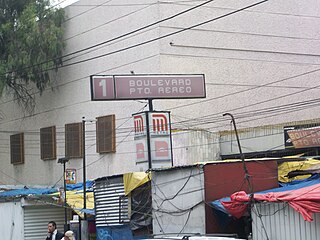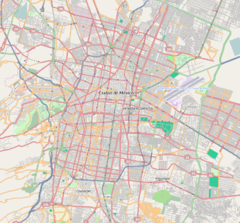
Insurgentes is a station on the Line 1 of Mexico City Metro. It is located within the Glorieta de los Insurgentes at the intersection of Avenida de los Insurgentes and Avenida Chapultepec in Mexico City's Cuauhtémoc borough, close to the Zona Rosa shopping and entertainment district and the Colonia Roma, two of the most iconic neighborhoods in the city. In 2019, the station had an average ridership of 65,134 passengers per day, making it the 12th busiest station in the network.

San Lázaro is a station on the Mexico City Metro. It is located in the Venustiano Carranza borough of Mexico City. It lies along Lines 1 and B. The station was opened on 5 September 1969. The station was designed by Félix Candela and consists of interlocked hyperbolic paraboloidal or saddle roof sections.

Aragón is a station of the Mexico City Metro in Gustavo A. Madero and Venustiano Carranza, Mexico City. It is a surface station with 1 island platform, served by Line 5, between Eduardo Molina and Oceanía stations. Aragón station serves the colonias Casas Alemán and Simón Bolívar. The station is named after the San Juan de Aragón Forest, and its pictogram represents the silhouette of a squirrel. Aragón station was opened on 19 December 1981, on the first day of the Consulado–Pantitlán service.

Boulevard Puerto Aéreo is a station on the Mexico City Metro. It is located in the northeast of Mexico City, near the western perimeter of the Benito Juárez International Airport. It lies alongs Line 1.

Terminal Aérea is a station of the Mexico City Metro, located next to the Mexico City International Airport in Venustiano Carranza, Mexico City. It is an underground station with 2 side platforms, served by Line 5, between Oceanía and Hangares stations. The station serves colonias Peñón de los Baños and Moctezuma 2ª sección.

Metro Martín Carrera is a station on the Mexico City Metro. It is located at the borders of the Colonia Martín Carrera, Colonia 15 de Agosto, and Colonia Díaz Mirón districts in the Gustavo A. Madero borough, in the north of Mexico City. The station logo depicts bust of General Martín Carrera, a national hero who fought in the Mexican–American War of 1846–48.

Metro Moctezuma is a station on Line 1 the Mexico City Metro. It is located in the Colonia Moctezuma and Colonia Balbuena neighborhoods of the Venustiano Carranza borough, to the northeast of the centre of Mexico City.

Metro Balbuena is a station along Line 1 of the Mexico City Metro. It is located in the Venustiano Carranza borough, to the northeast of the centre of Mexico City and serves the Colonia Jardin Balbuena and Colonia Moctezuma neighborhoods. The station was opened on 5 September 1969.

Gómez Farías is a station on Line 1 of the Mexico City Metro. It is located in the Colonia Federal and Colonia Gómez Farías neighborhoods of Venustiano Carranza borough, to the northeast of downtown Mexico City.

Metro Colegio Militar is a station on Line 2 of the Mexico City Metro system. It is located in the Miguel Hidalgo municipality of Mexico City, northwest of the city centre, on Calzada México-Tacuba. In 2019 the station had an average ridership of 15,275 passengers per day.

Metro Allende is a station on Line 2 of the Mexico City Metro system. It is located in the Colonia Centro district of the Cuauhtémoc municipality of Mexico City, on Tacuba street west of the main square in downtown. In 2019 the station had an average ridership of 28,873 passengers per day.

Metro Hospital General is a metro station along Line 3 of the Mexico City Metro. It is located in the Cuauhtémoc borough of Mexico City.

Misterios is a station of the Mexico City Metro in Cuauhtémoc and Gustavo A. Madero, Mexico City. It is an underground station with 2 side platforms, served by Line 5, between La Raza and Valle Gómez stations. Misterios station serves the colonias Peralvillo and Vallejo.

Valle Gómez is a station of the Mexico City Metro in Gustavo A. Madero and Venustiano Carranza, Mexico City. It is an underground station with two side platforms, served by Line 5, between Misterios and Consulado stations. Valle Gómez station serves the colonias 7 de Noviembre and Valle Gómez; the station receives its name from the latter. The station's pictogram features an agave plant. Valle Gómez was opened on 1 July 1982, on the first day of the La Raza–Pantitlán service.

Eduardo Molina is a station of the Mexico City Metro in Gustavo A. Madero and Venustiano Carranza, Mexico City. It is a surface station with 1 island platform, served by Line 5, between Consulado and Aragón stations. Eduardo Molina station serves the colonias 20 de Noviembre and Malinche. The station is named after Eduardo Molina Arévalo, an engineer who helped to solve the problem of water scarcity in the Valley of Mexico in the mid-20th century, and its pictogram represents two hands taking water, as featured on the mural El agua, origen de la vida, painted by Mexican muralist Diego Rivera in the Cárcamo de Dolores, in Chapultepec, Mexico City. Eduardo Molina station was opened on 19 December 1981, on the first day of the Consulado–Pantitlán service.

Hangares is a station of the Mexico City Metro in Venustiano Carranza, Mexico City. It is an underground station with 2 side platforms, served by Line 5, between Terminal Aérea and Pantitlán stations. Hangares station serves the colonia Federal, located next to the Mexico City International Airport. The station was opened on 19 December 1981, on the first day of then Consulado–Pantitlán service. The station's pictogram features a biplane inside a hangar.

Metro Agrícola Oriental is a metro station on Line A of the Mexico City Metro system. It is located in the Iztacalco municipality. In 2019, the station had an average ridership of 11,317 passengers per day, making it the least used station in Line A.

Metro Canal de San Juan is a station along Line A of the Mexico City Metro. It is located in the Iztacalco municipality. In 2019, the station had an average ridership of 13,189 passengers per day.

Tepalcates is a station on the Line A of the Mexico City Metro. It is located in the Iztapalapa municipality, to the east of downtown Mexico City.. In 2019, the station had an average ridership of 19,326 passengers per day.

Santa Marta is a station along Line A of the Mexico City Metro. It is located in the Colonia Ermita Zaragoza neighborhood of the Iztapalapa borough in Mexico City.





















